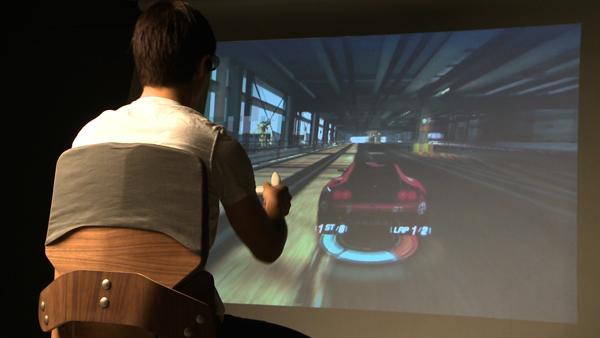
Immersive video games could soon be taken to a whole new level if a new tactile technology that creates high-resolution, continuous, moving tactile sensations anywhere on the body becomes mainstream. Called Surround Haptics, this new feedback mechanism was developed by Disney Research, Pittsburgh (DRP) in collaboration with Carnegie Mellon University.
Imagine a world where a Game Boy meets a Magic Fingers vibrating bed.
The notion, said Ivan Poupyrev, senior research scientist at DRP, is to create an environment that immerses the user in a world of tactile stimulation. Its secret is Tactile Brush, an algorithm that controls an array of vibrating actuators to produce smooth strokes that draw on the skin using tactile grids.
Poupyrev invented and developed Surround Haptics with Ali Israr, DRP's principal researcher on the technology.
With an extensive repertoire of touches and sensations, ranging from a bug crawling on the skin to drops of rain pouring on the body to the stroke of a sword, acceleration and free fall, Israr told TechNewsDaily that the technology is highly scalable and can be used to replicate a variety of real-world sensory experiences.
"The main feature of tactile feedback is that it can create a perception of continuous motion on the skin," Israr said.
Disney demonstrated Surround Haptics at the Emerging Technology Exhibition at SIGGRAPH 2011, the International Conference on Computer Graphics and Interactive Techniques in Vancouver.
Stay in the know with Laptop Mag
Get our in-depth reviews, helpful tips, great deals, and the biggest news stories delivered to your inbox.
For that demonstration, the team worked with Disney's Black Rock Studio to develop a high-intensity driving simulator game. Surround Haptics enabled the players, who were seated in a gaming chair equipped with vibrating actuators, to feel road imperfections, sense skidding, braking and acceleration and experience ripples of sensation when cars crashed into each other or landed after bring lofted into the air.
"Although we have only implemented Surround Haptics in a gaming chair to date, the technology can be easily embedded into clothing, gloves, sports equipment and mobile computing devices," said Poupyrev. "The possibilities are endless."
Surround Haptics may have been born in the land of fun and games, but its creators also foresee its future in real-world applications that can assist the disabled or enhance situational awareness for drivers and aircraft pilots.
"A vest or handheld version could be used as an assisted navigation aid for the blind, such as signaling an object approaching from the side," Israr said. Or “it could be embedded in a driver's seat to provide direction and attention cues and warn of objects in a blind spot. Pilots could use this for orientation to reduce sensory overload."
Though the technology is not that far removed from the drawing board, it wouldn't take long to integrate it into products, Poupyrev said.
"In terms of commercial application, the basic technology is more or less ready," Poupyrev said. "However, a lot of work needs to be done to create tools that would allow designers to create applications easily as well as develop reference designs. The technology cannot be used by itself—it has to be integrated into other products such as a gaming chair or motorcycle vest. If a customer is interested in Tactile Brush, then integration into product could be done relatively quickly. We are talking several months here, not years."
Surround Haptics also has the potential to be a disruptive technology, heavily affecting the gaming industry. But Poupyrev doesn't want to see it end there.
"I hope the movie industry will be disrupted," he said. "We want to see it in the movies. Of course, I understand that it is a difficult and long process."
Article provided by TechNewsDaily, a sister site of Laptopmag.com.
